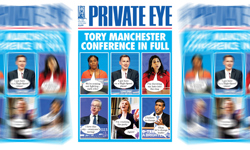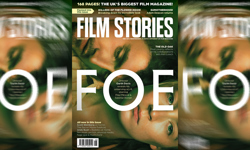Throughout the recession, Condé Nast was regularly in the media spotlight thanks to how well its high-end glossies - which include Vogue, Tatler and Vanity Fair - weathered the economic downturn. As noteworthy as the robustness of these titles' revenues, however, is the confidence this has given their publisher to extend its brands in diverse and unexpected ways.
For today's Condé Nast with its fast-growing events business, branded restaurants, clubs and bars and now even its own fashion college is no longer the traditional magazine publishing house it was just a few years ago. Though as UK managing director Nicholas Coleridge is quick to stress: high quality, engaging, entertaining content still underpins everything it chooses to do.
"Our aim is to produce beautiful, well-crafted magazines with integrity which are full of interesting journalism that caters for each particular market," he explains. "But digital has forced all publishers to push the boundaries of everything they do."
This hasn't just meant extending activities online - which Condé Nast first did eighteen years ago with the launch of vogue.com - and creating enhanced digital editions of its titles for consumption via mobile devices, including tablets.
It's also meant developing new, digital-only brands - such as just-launched online lifestyle destination House. And it's meant ensuring experience of its brands is more engaging and immersive in the real world, too. To date, Condé Nast International has opened a Vogue Café, GQ Bar and Tatler Club in Moscow. Vogue Cafés also exist in Dubai, where there is another GQ Bar, and Ukraine and in Bangkok there will soon be a Vogue Lounge.
Flourishing luxury sector
"We are lucky at Condé Nast to occupy the higher end of the market which means certain magazines have been protected," Coleridge explains.
"First by the London factor - the city is pulsing with English and rich foreigners who are heavy purchasers of luxury goods and glossy magazines. Luxury brands tend to target smaller and more discreet numbers than high street brands, so though they come at a price, Vogue, Tatler and Vanity Fair are a precise instrument with no waste for advertisers - bought by people who regularly participate in the world they write about."
Second, he adds: "By the fact that digital is growing stronger and stronger which is enlarging our overall audience. Meanwhile, at the top end of the market, it is still hard to beat the experience of a freshly minted magazine - the touch of its paper, the quality of its images, its particular scent all make it still a very attractive property."
Print sales of top end Condé Nast titles are healthy, he insists, pointing to recent ABCs showing actively purchased copies of Vogue up 5% period-on-period (and 2.1% year-on-year). Vogue’s latest ABC headline figure was 201,077. But it is overall readership he says the company - and, increasingly, advertisers - care most about, and when print and digital sales are viewed together, brand growth across the portfolio is strong.
Sluggish middle market
"The mid-market has certainly been a tougher marketplace, and a big frustration is the array of options now competing for people's free time," he continues. "Glamour's prints sales have slipped from 500,000 to closer to 400,000. But it remains the market leader. It is the UK's largest women's website. And readers' interaction with the brand is greater than ever."
Glamour's latest ABC of 415,258 copies represents a 2.5% increase PoP. However sales of the digital edition were up 4.4% PoP and 12.2% YoY. But, latest figures for the Glamour website show it is attracting 3.346m monthly uniques (Google Analytics, March-May 2014) - a far more dramatic upswing online from the 2.504m monthly uniques logged for the same period a year before.
Coleridge is a firm advocate of the need for advertisers - and publishers - to see the bigger picture: doing business on all readers, not just print copies sold. Demand for more and more information is an understandable obsession for ad agency "data wonks", he says, but there is already a mass of information sufficient to inform their buying decisions.
Digital profits
While some talk of digital struggling to achieve the potential publishers hoped for, Coleridge's position is, it's still too soon to say: "Generally, margins are not as good for digital as for print. But what we do have is a profitable digital business here."
Enhanced digital editions of its magazine brands have been a focus for Condé Nast in the past few years. But websites are another important strand for the volume of content they can carry, and the ability to make that content timely and responsive. Vogue, for example, puts out up to 25 new stories online each day while for Glamour it's anything up to 35. Tatler, meanwhile, is now able bring its readers the latest information within minutes from up to five society parties in a night.
Condé Nast has recently strengthened its proposition to advertisers with the launch of Condé Nast Digital Studio - a cross-platform, integrated digital and non-digital content solutions service. "It's all about making things simpler for brands," Coleridge says. "Some remain firmly rooted in print advertising - fashion brands, especially. Some - like car brands - are moving rapidly towards digital. Others, meanwhile, continue to straddle both. What we have to do is to make sure we cater to the needs of all."
Digital is not just about extending reach, however. It has also enabled Condé Nast's brands to become more accessible and interactive - a philosophy which is driving the company's brand extensions in the physical world.
Brand extensions
Since the start of the recession, Condé Nast UK has developed the Vogue Festival, now in its third year; Tatler's Bystander ball for 13 to 16 year-olds; GQ's first Comedy Extravaganza, which took place in March; Condé Nast Traveler’s writing master classes; and a series of future-gazing events hosted by Wired magazine which also now provides a business consultancy service.
And that's not to mention The Condé Nast College of Fashion & Design, now in its second year, which offers students - many of whom apply after completing a fashion-related undergraduate course elsewhere - industry insight and contacts they need to make fashion their full-time career. For now, the college has just one site in central London. However the company is now exploring the viability of opening additional branches elsewhere, including China and Russia.
"We try to think of things to do with our brands that are consistent, relevant and fun," Coleridge explains. "But while each undoubtedly adds lustre to its brand, everything we do we do to make money."
Condé Nast College will be "within 5% of profitability" this year and Coleridge expects it to make "a minimum 10% margin" in 2015: "I think it will be able to make the same level of profit as one of our smaller (UK) magazines." The restaurants, meanwhile, are already turning a profit and doing great business promoting the Vogue, Tatler and GQ brands - especially in Hong Kong, Singapore and the Middle East.
Another growing focus moving forward is video - now overseen, along with all other digital activity, by recently appointed tech entrepreneur Wil Harris. Harris, co-founder of YouTube multi-channel network provider Channel Flip, took over as Condé Nast UK head of digital in the spring replacing Jamie Jouning who became publisher of Glamour. The aim is to distribute more of Condé Nast's brands' content across more platforms while continually building the brands' social media activity which, in turn, generates an estimated 30% of its websites' traffic.
Not forgetting print…
New product development isn't just restricted to the digital world, Coleridge insists - though he readily concedes the challenges for a print launch in today's climate are getting greater.
"In the olden days, if you had a new idea for a print title, you could do it with a small number of people and put it out on the newsstand without much fanfare to see what happened. But you just can't do this now - not least as retailers expect each new launch to have a major marketing push," he says. "That's the conundrum all magazine publishers now face: bets have got bigger."
But that's not to say magazine publishing is a dead duck. Far from it, in fact. "All of us have had to reinvent ourselves," he concedes. "But the fact remains that Condé Nast now sells twice the number of magazines it did twenty years ago and in any other industry, that would be described as a boom time, or bonanza."
In the end, whether it is digital or printed products people choose to buy, it will be the quality of content which will dictate tomorrow's publishing world's winners and losers, Coleridge believes.
"Over the years to come, we will see a thinning of the market as the number of print titles published declines - and we think and expect every one of our own titles to be a survivor," he predicts. Condé Nast's will be an ever-increasing digital business and an ever-increasing multimedia business, too, though this will be "alongside a solid and admired rump of glossy print business". And the engine that drives it all will be great content.
"What makes me sad is when you hear a publishing company has appointed a new boss from BT or Orange because the challenge is content, not laying a cable," he adds. "We need to work as hard as we can to make our brands more engaging, more entertaining and more beautiful products than our competitors' - that's the real challenge."












